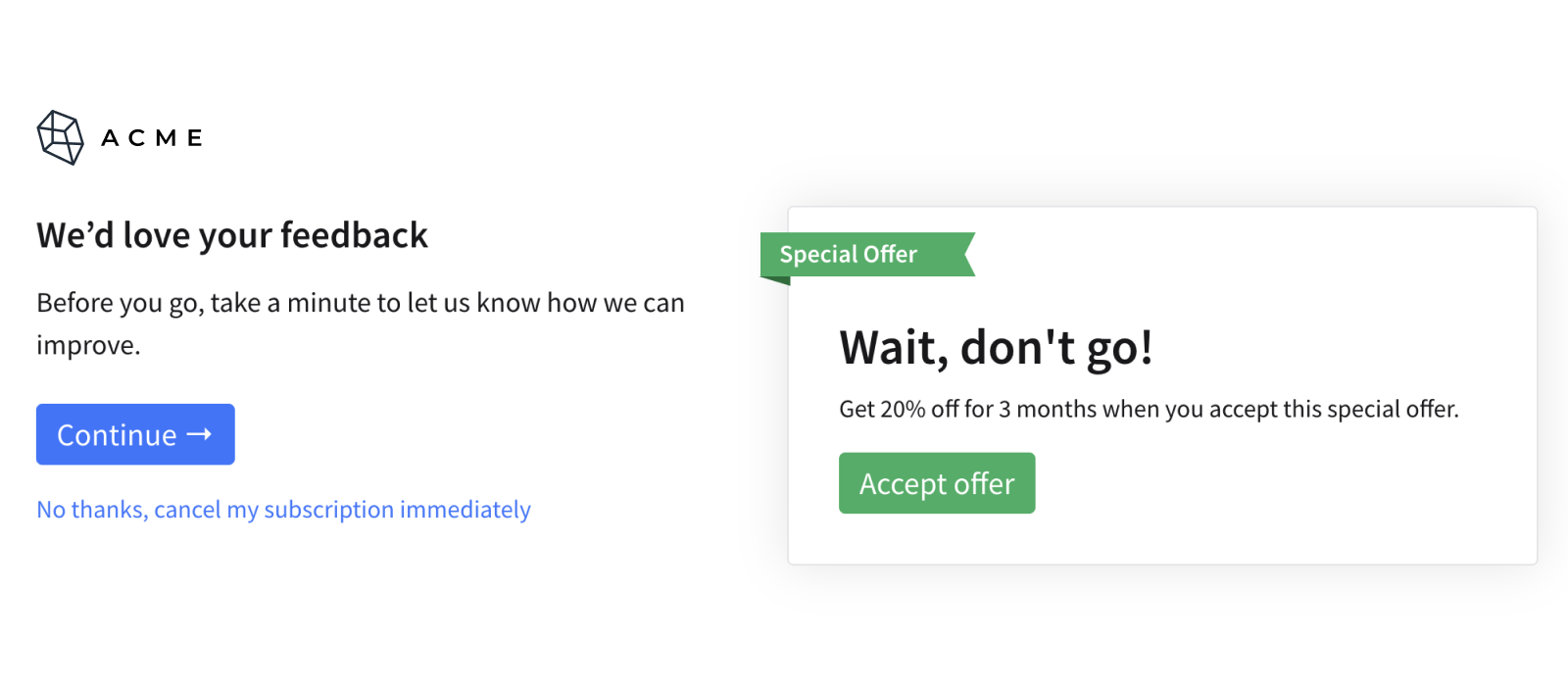FTC: The End of Call-to-Cancel Policies

The hammer has fallen on call-to-cancel. Fortunately, setting up a compliant self-service cancellation process doesn’t have to be hard—and can actually reduce churn.
In 2021 the FTC announced plans to ramp up enforcement of the Restore Online Shoppers’ Confidence Act (ROSCA), which protects consumers against deceptive online billing practices.
In the announcement the FTC took aim at businesses engaging in illegal “dark patterns” that obscure important subscription details and make cancellation difficult.
1. Given complaints about unauthorized charges & impossible-to-cancel billing, FTC has issued a policy statement making clear that firms that trick customers into signing up for subscriptions or trap them when they try to cancel are breaking the law. https://t.co/y0LkZWvVFY
— Lina Khan (@linakhanFTC) October 29, 2021
Under the law, businesses face legal consequences unless they:
“Clearly and conspicuously” disclose all subscription terms, including price, billing frequency and how to cancel.
Obtain “express informed consent” for recurring charges.
Provide “easy and simple” cancellation procedures. Cancellation must be “at least as easy” as signup.
Since then the FTC has filed several high-profile lawsuits for violations of ROSCA, including against Adobe and Amazon.
The FTC’s recent “click to cancel” proposal, initiated in 2023, aims to clarify and consolidate these provisions, providing a consistent legal framework for automatic renewals and cancellations.
Subscription regulations are constantly in flux. Subscribe to stay up-to-date on the latest compliance developments, churn-prevention strategies and more.
State-based regulations
These actions at the national level mirror similar automatic renewal regulations in California, New York and other states. Florida and Idaho require businesses to allow consumers to cancel via the “same means” as they used to sign up. Many states model their statutes after California’s, which is widely considered the strictest in the country.

California’s law requires businesses to provide a “cost-effective, timely and easy-to-use” cancellation mechanism, such as a toll-free phone number, e-mail address or cancellation flow.
Furthermore, for California consumers who signed up online, businesses must provide a “click to cancel” option—without requiring customers to complete a questionnaire or jump through any other hoops.
In effect, these developments mark the end of call-to-cancel policies for most online subscription-based businesses. If you accept signups online, you will need to allow customers to cancel online, too.
But don’t despair. Allowing self-service cancellation is good for consumers and business.

Why “easy and simple” cancellation is good for everybody
It’s clear how these regulations benefit consumers, but businesses may understandably worry that making cancellation easier will harm customer retention and the bottom line.
The good news is cancellation flow software provides a compliant alternative that effectively reduces churn.
I’ve seen dramatic results introducing Cancel Flows, including an immediate 15% reduction in churn… where the in-app Cancel Flow replaced the need to call in.
— Lincoln Murphy, Two Ways to Reduce SaaS Cancellations
In fact, allowing online self-service cancellation can both reduce call center strain and improve your save rate—significantly. That’s just what one ProsperStack customer discovered:
When the Minnesota Star Tribune introduced online cancellation, they did so with some trepidation. Like many businesses, they feared making cancellation easier could harm customer retention.
But with ProsperStack Retain’s powerful A/B testing features, the Star Tribune optimized their cancellation process and obtained an online save rate of 18.5%. That’s 10% higher than their call center.
“ProsperStack is one of the most important and impactful things we’ve implemented in several years,” the paper’s head of retention remarked.
See the case study.
The top five reasons self-service cancellation is good for business
Cancellation flows automate customer retention at scale. With powerful segmentation, targeted offers and personalized deflections that can be tested and optimized, cancellation flows can reduce churn 10-39%.
Customers prefer it. When possible many customers will choose user-friendly products and services, and avoid those perceived as draconian. Think cable companies.
It leaves a positive last impression. Meaning improved word of mouth and a higher chance of winning back the customer in the future. The reality is, many customers will be in the market for your product or service down the road, so don’t leave them with a bad taste in their mouth.
It’s cost effective. The administrative cost of processing cancellations by phone can really add up. With cancellation flows, the ROI is crystal clear.
It puts focus on improvement. Instead of milking your customer with coercive tactics, you’ll have to truly deliver exceptional value and outdo the competition. It makes you better.
Putting up roadblocks to cancellation only delays the inevitable, frustrates customers and sullies your brand reputation. And now in many cases it’s illegal to boot.

Online cancellation best practices
Keep these in mind when designing your cancellation flow:
Make your cancellation process quick and easy. Delight your customers by allowing them to update, change or cancel their subscriptions without any hassle. They’ll be more likely to return in the future and recommend you to others.
Collect feedback at the time of cancellation. Understanding why your subscribers cancel is crucial to your ongoing customer retention efforts. An exit survey helps identify weaknesses, pointing your team toward necessary improvements.
Reinforce value. Reminding your customer of the value they’re getting from your product or service will cause many to reconsider cancellation. Personalize with customer usage data from your app, CRM or other integrations.
Offer incentives and other alternatives to cancellation. Coupons, plan changes and free support are just a few of the options. With automation, all these can be personalized, tested and optimized, reducing churn up to 39%.
Consider providing an “instant cancellation” option for consumers in California. While the limits of California’s ARL have yet to be tested in court, the cautious choice for online businesses is to provide an instant cancellation option to California consumers (and states with similar laws) and a standard flow to others.

Want more? We cover all this in great detail, with examples from companies in SaaS, digital media and ecommerce:
Making the transition is easy with ProsperStack
With call-to-cancel and other tactics getting increased attention from state and national regulators, it’s time to invest in automated and compliant self-service cancellation. Replacing your call-in policy with online cancellation might seem difficult and risky, but the truth is it doesn’t have to be.
Schedule a demo to learn how ProsperStack can transform your cancellation process, reduce churn and help you retain more of your most valuable customers. In days, not months.


